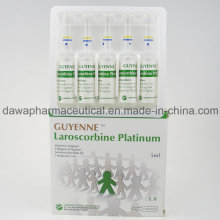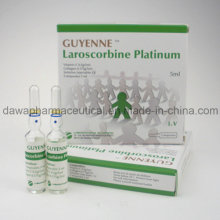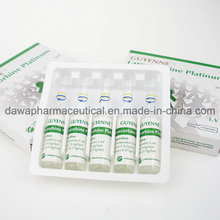Acide folique de stock de vitamine B9 et vitamine Bc et vitamine M
Acide folique de stock de vitamine B9 et vitamine Bc et vitamine M
| Type de paiement: | L/C, T/T, D/P, Western Union, Paypal, Money Gram |
|---|---|
| Quantité de commande minimum: | 1 |
| Délai de livraison: | 1 jours |
| productivité: | 10, 0000 Boxes Per Month |
|---|---|
| Lieu d'origine: | France |
| Capacité d'approvisionnement: | 10, 0000 Boxes Per Month |
Informations de base
Modèle: HEA451856M
Description du produit
N ° de Modèle: HEA451856M Mode d'Emploi: Pour l'administration orale Forme: Orale Liquide Technologie Pharmaceutique: Synthèse Chimique Marque et Origine: Guyenne, France Emballage: 10 AMPS/Tray/Box Échantillon: Acceptable Norme de Qualité: GMP / Qui GMP / Euro GMP Marque: guyenne Spécifications: GMP / OMS GMP / EURO GMP Code HS: 3004909090 Application: Médecine interne État: Liquide Type: Produits biologiques Nom: Acide folique Spécifications: 10 mg / ml MOQ: 1 boîte Délai de livraison: 7 jours Durée de conservation: 36 mois Paquet de transport: 10 AMPS Plateau / Boîte Origine: France Noms \ nIdentifiants \ nPropriétésPharmacologie
L'acide folique ou le folate est une vitamine B et une période; Il est également appelé vitamine M, vitamine B9, vitamine Bc, & lpar; ou folacine, acide ptéroyl-L-glutamique, et ptéroyl-L-glutamate & période; \ nLes fabricants de compléments alimentaires utilisent souvent le terme folate pour quelque chose de différent de "pur". "acide folique: en chimie, le folate se réfère à l'ion déprotoné, et l'acide folique à la molécule neutre, qui coexistent dans l'eau et la période; L'Union internationale de chimie pure et appliquée et l'Union internationale de biochimie et de biologie moléculaire déclarent que le folate et l'acide folique sont les synonymes préférés pour le ptéroylglutamate et l'acide ptéroylglutamique, respectivement & period; \ nVitamin B9 est essentielle pour de nombreuses fonctions corporelles & période; Les humains ne peuvent pas synthétiser les folates de novo & semi; par conséquent, l'acide folique doit être fourni par l'alimentation pour répondre à leurs besoins quotidiens et période; Le corps humain a besoin de folate pour synthétiser l'ADN, réparer l'ADN, et méthyler l'ADN ainsi que pour agir comme un cofacteur dans certaines réactions biologiques et période; Il est particulièrement important pour aider la division cellulaire rapide et la croissance, comme dans l'enfance et la grossesse et la période; Les enfants et les adultes ont tous deux besoin d'acide folique pour produire des globules rouges sains et prévenir l'anémie. Un manque de folates alimentaires peut entraîner une carence en folate et une période; Un manque complet de folate alimentaire prend des mois avant que la carence se développe comme les individus normaux ont environ 500-20 000 microgrammes & lpar; μg & rpar; de folate dans les magasins de corps et période; Cette carence peut entraîner de nombreux problèmes de santé, le plus notable étant les anomalies du tube neural chez les embryons en développement, une anomalie congénitale relativement rare affectant 300 000 & g; & period; 2 & percnt; & rpar; naissances dans le monde chaque année et 3000 grossesses aux États-Unis chaque année et période; Les symptômes courants de la carence en folate comprennent la diarrhée, l'anémie macrocytaire avec faiblesse ou essoufflement, les lésions nerveuses avec faiblesse et engourdissement des membres, la neuropathie périphérique, les complications de la grossesse, la confusion mentale, l'oubli ou d'autres déficits cognitifs, la dépression ou la langue enflée. ulcères peptiques ou buccaux, maux de tête, palpitations cardiaques, irritabilité et troubles du comportement et période; De faibles niveaux de folate peuvent également conduire à l'accumulation d'homocystéine et la période; De faibles niveaux de folate ont été associés à des cancers spécifiques et à des périodes; Cependant, il n'est pas clair si consommer recommandé & lpar; ou plus haut & rpar; des quantités d'acide folique - provenant d'aliments ou de suppléments - peuvent réduire le risque de cancer chez certaines personnes & période; \ n
| Folic acid | |
| IUPAC name (2S)-2-[[4-[(2-Amino-4-oxo-1H-pteridine6-yl)methylamino]benzoyl]amino]pentanedioic acid | |
| Other names N-(4-{[(2-amino-4-oxo-1,4-dihydropteridin-6-yl)methyl]amino}benzoyl)-L-glutamic acid; pteroyl-L-glutamic acid; Vitamin B9; Vitamin Bc; Vitamin M; Folacin | |
| CAS Number | 59-30-3 |
| ChEBI | CHEBI:27470 |
| ChEMBL | ChEMBL1622 |
| ChemSpider | 5815 |
| DrugBank | DB00158 |
| IUPHAR/BPS | 4563 |
| Jmol interactive 3D | Image |
| KEGG | C00504 |
| PubChem | 6037 |
| RTECS number | LP5425000 |
| UNII | 935E97BOY8 |
| Chemical formula | C19H19N7O6 |
| Molar mass | 441.40 g·mol?1 |
| Appearance | yellow-orange crystalline powder |
| Melting point | 250 °C (482 °F; 523 K) (decomposition) |
| Solubility in water | 1.6 mg/L (25 °C) |
| log P | -2.5 |
| Acidity (pKa) | 1st: 4.65, 2nd: 6.75, 3rd: 9.00 |
| ATC code | B03BB01 |
1 Health effects
Groupes de Produits : Produits anti-âge autres produits
Produits phares Comprimés de chlorhydrate d’Amiodarone 200mg de haute qualitéGrand Stock blanchir la peau crème MonobenzoneMédecine générale Omeprazole 20mg Injection pour Gastrohelcosis et acide gastriqueMédecine générale Ceftriaxone Sodium InjectionChlornitromycin pharmaceutique CAS 56-75-7 Chloroamphenicol pour usage vétérinaire (PAO-014)Peau de Stock prête C vitamine anti-vieillissement Injection de blanchimentNuméro 57-85-2 stéroïde Injectable composé de Propionate de testostéroneAcide usnique haute qualité avec haute puretéMuscle Builder poids perte Homebrew stéroïdes testostérone SustanonApprouvé par la FDA Curative artémisinine antipaludiqueMédecine traitement Brain Injury Citicoline sodique injectableChymolase Alpha protéase oedème inflammatoireInjection de l’acétate de médroxyprogestérone médecine généraleAmikacine Injection général médecine médicamentsInjection de glutathion Gsh personnels soins de blanchiment de la peauBody Fitness minceur perdre du poids poids perte L-Carnitine Injection2.0g / 5ml |















